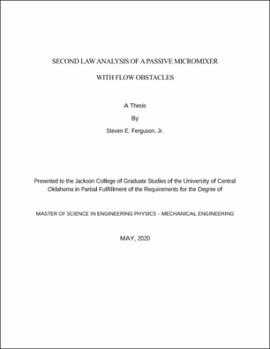| dc.contributor.author | Ferguson, Steven E. Jr. | |
| dc.date.accessioned | 2021-09-20T15:59:54Z | |
| dc.date.available | 2021-09-20T15:59:54Z | |
| dc.date.issued | 2020 | |
| dc.identifier.uri | https://hdl.handle.net/11244/330823 | |
| dc.description.abstract | Passive micromixers focus on variations in the channel geometry and the presence of flow obstacles as a means of improving mixing efficiency. An analysis of these geometries can provide useful information for further mixer design iteration. These passive micromixers have applications in biosciences, in particular as point-of-care diagnostic testing devices. Because these mixers utilize the channel geometry, rather than moving parts, to increase mixing efficiency, they can be more easily deployed in developing or relatively undeveloped locales. This thesis presents a detailed computational analysis of a channel design that utilizes obstacles that split and recombine the fluid flow in a rectangular microchannel. Numerical simulations were created using computational fluid dynamics software running on a supercomputer cluster. The Second Law of Thermodynamics is utilized to identify areas of irreversibility due to both chaotic advection induced by flow obstacles and diffusion. The design is analyzed for a range of Reynolds numbers typical to micromixers. Additionally, different inlet velocity ratios are analyzed to examine whether this can potentially improve mixing efficiency within this channel design. | en_US |
| dc.rights | All rights reserved by the author, who has granted UCO Chambers Library the non-exclusive right to share this material in its online repositories. Contact UCO Chambers Library's Digital Initiatives Working Group at diwg@uco.edu for the permission policy on the use, reproduction or distribution of this material. | |
| dc.title | Second Law Analysis of a Passive Micromixer with Flow Obstacles | en_US |
